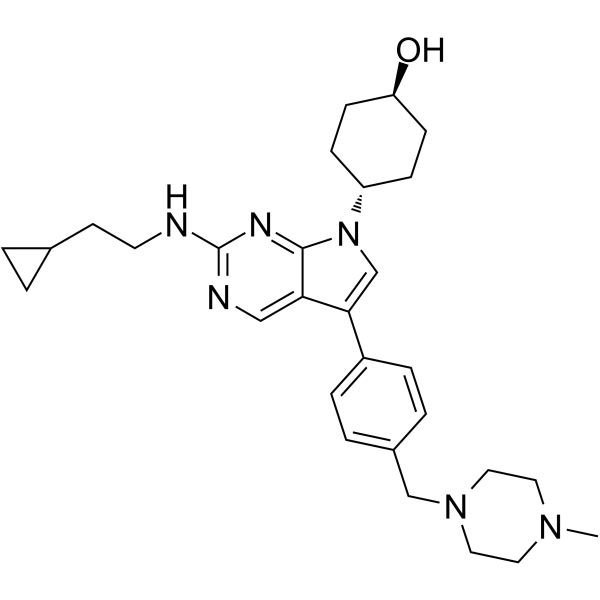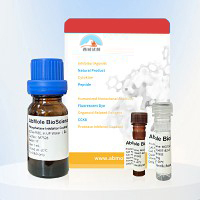MRX-2843 UNC2371,99.70%
产品编号:Bellancom-101549| CAS NO:1429882-07-4| 分子式:C29H40N6O| 分子量:488.67
本网站销售的所有产品仅用于工业应用或者科学研究等非医疗目的,不可用于人类或动物的临床诊断或者治疗,非药用,非食用,
MRX-2843 UNC2371
| 产品介绍 | MRX-2843 (UNC2371) 是一种具有口服活性的、ATP 竞争性的MERTK 和 FLT3 酪氨酸激酶抑制剂 (TKI),IC50 分别为 1.3 nM 和 0.64 nM。 | ||||||||||||||||
|---|---|---|---|---|---|---|---|---|---|---|---|---|---|---|---|---|---|
| 生物活性 | MRX-2843 (UNC2371) is an orally active, ATP-competitive dual MERTK and FLT3 tyrosine kinases inhibitor (TKI) with enzymatic IC50s of 1.3 nM for MERTK and 0.64 nM for FLT3, respectively. | ||||||||||||||||
| 体外研究 |
In the Kasumi-1 cell line, treatment with MRX-2843 results in dose-dependent inhibition of MERTK phosphorylation. Decreased phosphorylation is evident at concentrations as low as 10 nM, with near-complete abrogation of MERTK activation at 100 to 300 nM. Similarly, treatment of Kasumi-1 cells with MRX-2843 mediates inhibition of downstream signaling through pathways important for tumor cell survival and proliferation. MRX-2843 treatment results in a decrease in relative cell numbers, with an IC50 of 143.5±14.1 nM, indicating that MRX-2843 significantly inhibits tumor cell proliferation and/or survival. Similarly, there are 34.1%±5.6% and 67.1%±2.7% apoptotic and dead cells in NOMO-1 cultures treated with 150 nM or 300 nM MRX-2843, respectively, compare with 6.8%±0.7% in vehicle-treated cultures (P<0.001). Treatment with 50 nM and 100 nM MRX-2843 results in 62.3%±6.4% and 84.1%±7.8% inhibition of colony formation, respectively, in Kasumi-1 cultures (P<0.01). Similarly, in NOMO-1 cultures, colony formation is inhibited by 54.8%±18.1% in response to treatment with 100 nM MRX-2843 (P<0.001). In MOLM-14 cells, treatment with MRX-2843 inhibits phosphorylation of FLT3 and downstream signaling through STAT5, ERK1/2, and AKT. Activation of FLT3 and its signaling pathways is almost completely abrogated by treatment with 50 nM MRX-2843, indicating somewhat higher cellular potency against FLT3 relative to MERTK. 西域 has not independently confirmed the accuracy of these methods. They are for reference only. | ||||||||||||||||
| 体内研究 |
MRX-2843 is 78% orally bioavailable at a dose of 3 mg/kg with a Cmax of 1.3 μM and a t1/2 of 4.4 hours. In MOLM-14 parental xenografts, both quizartinib and MRX-2843 increase median survival compare with that of vehicle-treated mice (172.5 days versus 40 days and 121 days versus 36 days, respectively, P<0.001). In this model, quizartinib is more effective than MRX-2843 (P<0.005), although higher doses of MRX-2843 are not evaluated. In MOLM-14:D835Y xenografts, quizartinib prolongs survival compare with that of vehicle-treated mice, but the effect is minimal (median survival 45 days vs. 36 days, P<0.001). In MOLM-14:F691L xenografts, treatment with MRX-2843 prolongs survival by almost 2-fold in NSG and NSGS mice (median survival 87 vs. 44.5 days and 87 vs. 48 days, respectively, P<0.005). Increased survival is observed in response to treatment with MRX-2843 versus quizartinib, but the difference is only significant in NSG mice. 西域 has not independently confirmed the accuracy of these methods. They are for reference only. | ||||||||||||||||
| 体内研究 |
MRX-2843 is 78% orally bioavailable at a dose of 3 mg/kg with a Cmax of 1.3 μM and a t1/2 of 4.4 hours. In MOLM-14 parental xenografts, both quizartinib and MRX-2843 increase median survival compare with that of vehicle-treated mice (172.5 days versus 40 days and 121 days versus 36 days, respectively, P<0.001). In this model, quizartinib is more effective than MRX-2843 (P<0.005), although higher doses of MRX-2843 are not evaluated. In MOLM-14:D835Y xenografts, quizartinib prolongs survival compare with that of vehicle-treated mice, but the effect is minimal (median survival 45 days vs. 36 days, P<0.001). In MOLM-14:F691L xenografts, treatment with MRX-2843 prolongs survival by almost 2-fold in NSG and NSGS mice (median survival 87 vs. 44.5 days and 87 vs. 48 days, respectively, P<0.005). Increased survival is observed in response to treatment with MRX-2843 versus quizartinib, but the difference is only significant in NSG mice. 西域 has not independently confirmed the accuracy of these methods. They are for reference only. | ||||||||||||||||
| 性状 | Solid | ||||||||||||||||
| 溶解性数据 |
In Vitro:
DMSO : 20 mg/mL (40.93 mM; ultrasonic and warming and heat to 60°C) 配制储备液
*
请根据产品在不同溶剂中的溶解度选择合适的溶剂配制储备液;一旦配成溶液,请分装保存,避免反复冻融造成的产品失效。 In Vivo:
请根据您的实验动物和给药方式选择适当的溶解方案。以下溶解方案都请先按照 In Vitro 方式配制澄清的储备液,再依次添加助溶剂:
——为保证实验结果的可靠性,澄清的储备液可以根据储存条件,适当保存;体内实验的工作液,建议您现用现配,当天使用;
以下溶剂前显示的百
| ||||||||||||||||
| 运输条件 | Room temperature in continental US; may vary elsewhere. | ||||||||||||||||
| 储存方式 |
| ||||||||||||||||
| 参考文献 |








 浙公网安备 33010802013016号
浙公网安备 33010802013016号